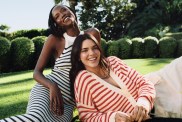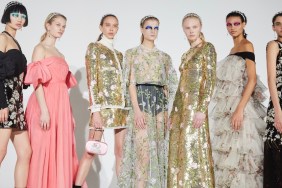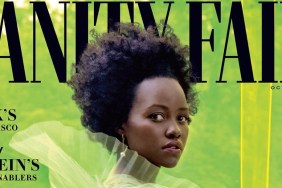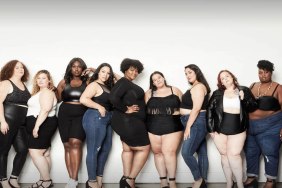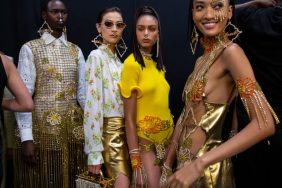It’s been a banner year so far for the plus-size industry: Model Ashley Graham was the first plus-size woman to appear on the cover of Sports Illustrated Swimsuit Issue, Glamour magazine released its first-ever plus-size issue and IMG launched a plus-size male model division, to name just a few developments. Despite these high-profile headlines, our recent diversity reports show that plus-size women are still grossly underrepresented in fashion ad campaigns and on the runways. A fact that seems rather short-sighted when you consider that U.S. plus-size apparel sales increased by a whopping 17 percent between 2013 and 2016 — that’s a $20.4 billion jump.
Bloggers CeCe Olisa and Chastity Garner Valentine are on a mission to bring more visibility to the plus-size market with theCURVYcon, the nation’s only convention dedicated to plus-size fashion. Now in its second year, theCURVYcon brings plus-size brands, fashionistas, bloggers and YouTubers together to embrace their curves, shop the latest styles and tackle topics ranging from confidence, health and fitness to fashion, style, dating and body positivity. We sat down with CeCe and Chastity ahead of the conference (June 17-18 in New York City) to get their thoughts on the current state of the plus-size fashion industry.
theFashionSpot: What are your thoughts on the term “plus-size”?
CeCe Olisa: I spent my teen years being ashamed of that term plus-size, now I embrace it fully. It makes shopping easier and it helps our community find each other. I’m in no rush to stop using it.
Chastity Garner Valentine: For me it’s a useful term to guide my readers to the fashion that they are looking for. It’s a common term in search engines. I think the term gets a bad rap because of attached feelings to a term to describe a set of sizing. For me, I attach function to the word. Plus-size, just like petites or juniors, is used to help the shopper find what they are looking for. Imagine having to google a dress in plus-sizes without the terms. Finding that garment would be like searching for a needle in a haystack. In theory, yes, it would be great to get rid of terms and labels that separate fashion, but until all fashion is made in all sizes for all heights, then that just isn’t realistic.

Model Ashley Graham at theCURVYcon; Image: Bennett Raglin
tFS: What are your thoughts on the state of the plus-size fashion industry?
CeCe: I’m waiting for the day when women are no longer excluded from the fashion industry because of their size. Style has nothing to do with size, but sadly, plus-size women aren’t able to fully express their style the way they want to because the fashion industry doesn’t fully embrace plus-size women. I can’t wait for a shift in that thinking.
Chastity: I started in the industry circa 2005 when there were so few options for a plus-size woman, let alone a plus-size woman under the age of 50. So many more options have come along and I love the growth. I still see a lot of negative feedback about the plus options and I do agree, but there are a lot of good options. There is also still a lot of room for growth.
tFS: How diverse would you consider the fashion industry to be? Do you feel the industry is becoming more or less body positive?
Chastity: I have a lot of internal conflict when it comes to this. I feel like mainstream fashion is becoming more inclusive of plus-size fashion and plus-size people, but only a certain type of plus-size girl. She’s hourglass, tall, a size 14 and, most times, white. A lot of the growth and attention in the plus-size industry has come from the bottom up and from women of color, but once plus-size became mainstream the less diverse the industry has become. The plus-size fashion industry feels, as it relates to fashion, like it’s a different side of the same fashion coin, where only a few people who look the same are allowed in the door.
I feel like I can’t give my full evaluation of the body positivity concept until the word is no longer a buzzword. For me, are we body positive because it’s trendy or are we positive because it’s the right way to be. That has yet to be seen.
CeCe: I see the industry making an effort toward diversity, but there is so much room for improvement and inclusion. It is so powerful to see women who look like you reflected in mainstream media and we need more of that. Of course, I’m able to have a job as a YouTuber/blogger because I fill that void, so clearly we’re not holding our breath. The Internet gives us the power to create the diversity we want to see. That’s why Chastity and I do what we do. That’s why we created theCURVYcon.

TheCURVYcon; Image: Bennett Raglin
tFS: Who do you feel is leading the way in terms of body acceptance?
CeCe: Amber Riley, Ashley Nell Tipton, Iskra Lawrence all inspire me on a daily basis. I love that Eloquii uses models of all sizes.
Chastity: I love what Jes Baker, Gabi Gregg, Nicolette Mason and Susan Moses are doing. Through fashion, they are helping women accept themselves.
tFS: What kind of misconceptions do you feel people within the industry have about plus-size women?
CeCe: They think we don’t want to spend money on clothes! They think we’re waiting until we lose weight to get into fashion. Both of these things aren’t true.
Chastity: That our bodies prevent us from being stylish. I’ve seen many fashionable plus-size women. It’s just that we didn’t have the options before.
tFS: What’s your ideal trajectory for the plus-size movement?
CeCe: I want plus-size women to feel valuable and deserving of beautiful things.
Chastity: I want people to live their lives to the fullest and to not think of their bodies as a hindrance, but as an asset.



